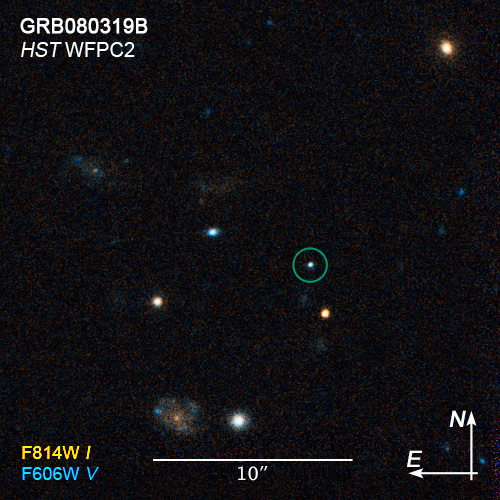1 min read
Hubble Pinpoints Record-Breaking Explosion

Peering across 7.5 billion light-years and halfway back to the Big Bang, NASA's Hubble Space Telescope has photographed the fading optical counterpart of a powerful gamma ray burst that holds the record for being the intrinsically brightest naked-eye object ever seen from Earth. For nearly a minute this single star was as bright as 10 million galaxies.
Hubble Wide Field and Planetary Camera 2 (WFPC2) images of GRB 080319B, taken on Monday, April 7, show the fading optical counterpart of the titanic blast. The object erupted in a brilliant flash of gamma rays and other electromagnetic radiation at 2:12 a.m. EDT on March 19, and was detected by Swift, NASA's gamma ray burst watchdog satellite. Immediately after the explosion, the gamma ray burst glowed as a dim 5th magnitude "star" in the spring constellation Bootes. Designated GRB 080319B, the intergalactic firework has been fading away ever since then. Hubble astronomers had hoped to see the host galaxy where the burst presumably originated, but were taken aback that the light from the GRB is still drowning out the galaxy's light even three weeks after the explosion. This is particularly surprising because it was such a bright GRB initially.
Previously, bright bursts have tended to fade more rapidly, which fits in to the theory that brighter GRBs emit their energy in a more tightly confined beam. The slow fading leaves astronomers puzzling about just where the energy came from to power this GRB, and makes Hubble's next observations of this object in May all the more crucial. Called a long-duration gamma ray burst, such events are theorized to be caused by the death of a very massive star, perhaps weighing as much as 50 times our Sun. Such explosions, sometimes dubbed "hypernovae," are more powerful than ordinary supernova explosions and are far more luminous, in part because their energy seems to be concentrated into a blowtorch-like beam that, in this case, was aimed directly at Earth. The Hubble exposure also shows field galaxies around the fading optical component of the gamma ray burst, which are probably unrelated to the burst itself.
About the Object
- R.A. PositionR.A. PositionRight ascension – analogous to longitude – is one component of an object's position.14h 31m 40.99s
- Dec. PositionDec. PositionDeclination – analogous to latitude – is one component of an object's position.36° 18' 9.0"
- ConstellationConstellationOne of 88 recognized regions of the celestial sphere in which the object appears.Boötes
- DistanceDistanceThe physical distance from Earth to the astronomical object. Distances within our solar system are usually measured in Astronomical Units (AU). Distances between stars are usually measured in light-years. Interstellar distances can also be measured in parsecs.7.5 billion light-years or 2.3 billion parsecs
- DimensionsDimensionsThe physical size of the object or the apparent angle it subtends on the sky.This image is 25 arcseconds (91,000 light-years or 28,000 parsecs) square.
About the Data
- Data DescriptionData DescriptionProposal: A description of the observations, their scientific justification, and the links to the data available in the science archive.
Science Team: The astronomers who planned the observations and analyzed the data. "PI" refers to the Principal Investigator.HST Proposal: 11513 N. Tanvir, K. Wiersma, and E. Rol (University of Leicester), A. Fruchter (STScI), and A. Levan (University of Warwick). - InstrumentInstrumentThe science instrument used to produce the data.HST>WFPC2
- Exposure DatesExposure DatesThe date(s) that the telescope made its observations and the total exposure time.April 7, 2008, Exposure Time: 1.8 hours
- FiltersFiltersThe camera filters that were used in the science observations.F606W (V) and F814W (I)
- Object NameObject NameA name or catalog number that astronomers use to identify an astronomical object.GRB 080319B
- Object DescriptionObject DescriptionThe type of astronomical object.Gamma Ray Burst
- Release DateApril 10, 2008
- Science ReleaseHubble Pinpoints Record-Breaking Explosion
- Credit

The image is a composite of several separate exposures made by the WFPC2 instrument on the Hubble Space Telescope. Two filters were used to sample broad wavelength ranges in the yellow and near infrafed. The color results from assigning different hues (colors) to each monochromatic image. In this case, the assigned colors are: Blue: F814W (I) Orange: F606W (V)

Share
Details
Claire Andreoli
NASA’s Goddard Space Flight Center
Greenbelt, Maryland
claire.andreoli@nasa.gov




























